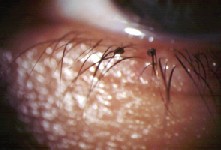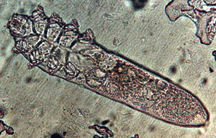Q. I suspect a 78-year-old aphakic lens wearer with itching and burning eyelids has Demodex. What is the life cycle and how do I diagnose it?

A. Demodex folliculorum is a four-legged, elongated and semi-transparent parasitic mite, which resides in the ducts of the sebaceous glands that are near or connected to hair follicles.1 Demodex, which is a form of blepharitis, lives between 18-24 days, during which the females lay 20-24 eggs.
Some infestations may be related to poor hygiene, perioral dermatitis, rosacea and diabetes, though incidence of Demodex apparently increases with age, mostly affecting the elderly.2-4
If a patient has red eyes, thickened eyelids at the margin, redness along the margin, perhaps a loss of lashes and complains of itching and burningwhich may be exacerbated during warmer weatheryou should immediately suspect lid disease, says Bobby Christensen, O.D., of Midwest City, Okla. And if I should notice a large group of eyelashes missing and an ulcer or eroded spot on the lid, I am going to consider masquerade syndromes like basal cell carcinoma.
Left: Typical collarettes seen in blepharitis.


Right: Demodex folliculorum.
According to Jacksonville, Fla., optometrist Louis Catania, Demodex, like other forms of blepharitis, appear as collarettes around the base of the lashes (which can be seen by the naked eye if there are enough of them) and therefore, make the hair follicle appear as a puckered pyramid. You will observe a concretion or an exudate surrounding the lash, Dr. Cantania says.
Epilation of several lashes, when floated on viscous fluid under light microscopy, will reveal the mites. If six or more are found on 16 epilated lashes, there is an overpopulation.
Q. Can we ever get rid of Demodex when it inhabits the lid area?
A. Demodex can never completely be eliminated, but the infestation can be controlled. It is the toxins and the waste they give off that cause most of the reaction, so if you can reduce the population, that will basically keep the eyelids looking good and the patient comfortable, Dr. Christensen says.
Treatment consists of:
Lid scrubs. Since the adult mite hides in the hair follicle, its the physical manipulation and tugging that makes lid scrub the most effective form of treatment, says Joseph B. Fleming, O.D., of Birmingham, Ala.
Dr. Catania recommends morning, night and even mid-day lid scrubs, if possible.
Topical antibiotic. Demodex is often treatable with polymyxin B/bacitracin ointment. You want the patient to rub it in down to the base of the lash, twice a day, Dr. Christensen says. Fifteen minutes after they put the ointment in, in the morning, they should rinse their eyes out with saline solution, so they dont trap any of the ointment under the lens or smear the top of it.
Dietary changes. According to Robert Abel, M.D., of Wilmington, Del., by decreasing intake of Omega-6 fatty acids (eggs, for instance) and boosting Omega-3s (cod, for instance), you can take care of the problem in the long-run. One of the reasons we get seborrhea and related conditions is because of the dietary contributions to meibomian secretions, he says. But the oils from Omega-3 do not taste as good to them, so by changing your diet, since these oils get onto contact lenses, youll be limiting the annoyance.
1. Umar MH. Demodex, an inhabitant of human hair follicles, and a mite which we live with in harmony. Micscape Magazine, May 2000, www.microscopy-uk.org.uk/mag
/artmay00/demodex.html.
2. Sibenge S, Gawkrodger DJ. Rosacea: a study of clinical patterns, blood flow, and the role of Demodex folliculorum. J Am Acad Dermatol 1992 Apr;26(4):590-3.
3. Clifford CW, Fulk GW. Association of diabetes, lash loss, and Staphylococcus aureus with infestation of eyelids by Demodex folliculorum (Acari: Demodicidae). J Med Entomol 1990 Jul;27(4):467-70.
4. Norn MS. Incidence of Demodex folliculorum on skin of lids and nose. Acta Ophthalmol 1982 Aug;60(4):575-83.

